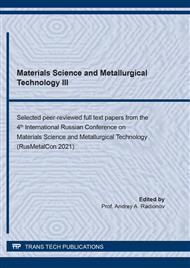[1]
M.M. Lakernick, G.M. Pakhomova, Zinc and Cadmium Metallurgy, Metallurgy, Moscow, (1969).
Google Scholar
[2]
V. Kamil, S. Yan, V. Yana, Zinc Rundown from Steelmaking Dust, Chemical Process Operations. 21 (2010) 739-744.
Google Scholar
[3]
A.A. Popov, G.V. Petrov, Disposal of zinc-containing dust from steelmaking, Irkutsk State Technical University Bulletin. 4 (2016) 169-177.
Google Scholar
[4]
A.A. Andersson, H. Ahmed, J. Rosenkranz, C. Samuelsson, B. Björkman, Characterization and upgrading of a low zinc-containing and fine blast furnace sludge - A multi-objective analysis, ISIJ International. 57 (2017) 262-271.
DOI: 10.2355/isijinternational.isijint-2016-512
Google Scholar
[5]
A.M. Panshin, L.I. Leontiev, P.A. Kozlov, V.G. Djubanov, A.V. Zatonsky, D.A. Ivankin, Processing of electric arc furnace dust of Severstal, JSC at Waeltz facility of Chelyabinsk pyrolysis plant, JSC, Environment and Industry of Russia. 11 (2012) 4-6.
DOI: 10.17580/tsm.2015.05.14
Google Scholar
[6]
Y. Zhou, L. Wu, J. Wang, H. Wang, Y. Dong, Separation of ZnO from the stainless steelmaking dust and graphite mixture by microwave irradiation, High Temperature Materials and Processes. 34 (2015) 177-184.
DOI: 10.1515/htmp-2013-0118
Google Scholar
[7]
J. Antrekowitsch, G. Rösler, S. Steinacker, State of the art in steel mill dust recycling, Chemil-Ingenieur-Technik. 87 (2015) 1498-1503.
DOI: 10.1002/cite.201500073
Google Scholar
[8]
B. Geier, H. Raupenstrauch, W. Reiter, K. Pilz, Processing of low zinc containing steel mill dusts with the recodust-process, in: Proceedings of the 6th International Congress on the Science and Technology of Steelmaking May, 2015, pp.951-953.
Google Scholar
[9]
X. Lin, Z. Penga, J. Yana, Z. Lia, J.-Y. Hwangb, Y. Zhanga, G. Lia, T. Jianga, Pyrometallurgical recycling of electric arc furnace dust, Journal of Cleaner Production. 149 (2017) 1079-1100.
DOI: 10.1016/j.jclepro.2017.02.128
Google Scholar
[10]
F.-P. Tang, S.-J. Yu, F. Qian, H.-Y. Hou, X.-F.Wang, X.-G. Ma. Research and practice on self-reductive dezincification of composite dust pellet, Kang T'ieh/Iron and Steel. 51 (2016) 89-93 and 111.
Google Scholar
[11]
P. Sarfo, A. Das, G. Wyss, C. Young, Recovery of metal values from copper slag and reuse of residual secondary slag, Waste Management. 70 (2017) 272-281.
DOI: 10.1016/j.wasman.2017.09.024
Google Scholar
[12]
P.A. Kozlov, A.M. Panshin, V.N. Vyatkin, Yu.V. Reshetnikov, Research and development of pyrometallurgical process of copper industry waste processing with zinc, Lead and Tin Removal, Ferrous Metals. 15 (2015) 46-50.
Google Scholar
[13]
A.M. Panshin, P.A. Kozlov, D.A. Ivankin, V.N. Vyatkin, Thermodynamic and kinetic analysis of zinc, lead and tin rundown in Waeltz Kiln when processing dusty polymetallic middling products of copper industry, Ferrous Metals. 8 (2013) 41-44.
Google Scholar
[14]
A.M. Panshin, R.M. Shakirzyanov, P.A. Izbrekht, A.V. Zatonsky, Major improvement areas of zinc manufacture at Chelyabinsk zinc plant, Ferrous Metals. 5 (2015) 19-21.
DOI: 10.17580/tsm.2015.05.03
Google Scholar
[15]
P. Khammershmidt, P. Hilbrans, Kh.Kh. Lackman, O. Fogt, Zinc and lead removal from dusts and slurries at agglomerate production, Ferrous Metals. 1 (1987) 25-30.
Google Scholar
[16]
G. Mayer, K.G. Fopel, V. Yansen, Processing of dust and slurry from blast furnace and converter plant gas cleaning in rotating furnaces, Ferrous Metals. 24 (1976) 3-7.
Google Scholar
[17]
I.N. Tanutrov, On zinc reduction with carbon, Bulletin of the USSR Academy of Sciences. Metals. 1 (1983) 11-15.
Google Scholar
[18]
A.S. Kolesnikov, Thermodynamic simulation of silicon, iron reduction and rundown of zinc, lead in zinc-limonite ore-carbon, University Bulletin. Ferrous Metallurgy. 5 (2014) 11-15.
DOI: 10.17073/0021-3438-2014-5-11-15
Google Scholar
[19]
L.M. Simonyan, A.A. Alpatova, Forecasting of zinc and lead performance at electric steel making, Metallurgist. 7 (2016) 36-37.
Google Scholar
[20]
G.V. Kortikov, S.L. Zevin, V.V. Grekov, Zinc performance at blast furnace and converter slurry agglomeration with the Kursk magnetic anomaly concentrates, Steel. 5 (2003) 2-6.
Google Scholar


